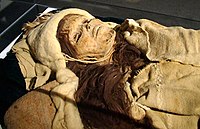Princess of Xiaohe
| Princess of Xiaohe | |
|---|---|
 The "Princess of Xiaohe" | |
| Material | Natural mummy |
| Created | 1800 BCE |
| Discovered | Xiaohe Cemetery |
The Princess of Xiaohe (Chinese: 小河公主) or Little River Princess was found in 2003 at Xiaohe Cemetery in Lop Nur, Xinjiang. She is one of the Tarim mummies, and is known as M11 for the tomb she was found in. Buried approximately 3,800 years ago, she has European and Siberian genes[1][2] and has white skin and red hair. She is unusually well preserved, with clothes, hair, and eyelashes still intact.
Discovery
[edit]
The Princess of Xiaohe was unearthed by the archaeologists of Xinjiang Institute of Archaeology at Xiaohe Cemetery No. 5, Tomb 11, 102 km (63 mi) west of Loulan, Lop Nur, Xinjiang in 2003.[3] They named her the Princess of Xiaohe due to her state of preservation and beauty, not her social status; there is no reason to believe she was any more important than the other mummies buried in the complex. She was part of the Xiaohe culture, and was buried around 3,800 years ago. She is unusually well preserved, with long eyelashes, clothes, and hair still intact.[4] Archeologists attribute this to the dry, salty conditions in the desert and tightly sealed coffins, which were wrapped in cowhide before being buried. As the cowhide dried out, it shrunk, sealing the coffins. Her body was not embalmed before death, but mummified naturally due to the climate and burial method.[5]
Appearances and grave goods
[edit]The Princess has red hair and long eyelashes, with some facial features more similar to Indo-Europeans than modern people of the region she was found in, such as high cheekbones and pale skin.[failed verification] She seems to be smiling slightly. She was 152 cm (5 ft 0 in) tall.[6] She was buried wearing a white felt hat, a white wool cloak with tassels, and string skirt, with fur-lined leather boots on her feet. She had a red rope necklace and a bracelet with one jade bead on her right arm. She was buried with wooden pins and three small pouches of ephedra. Twigs and branches of ephedra were placed beside the body. Wheat and millet grains, strings made from the tendons of animals, and animal ears were spread over her body. A wooden phallic object was placed between her breasts. Like the other mummies in Xiaohe Cemetery, she was buried in a boat-shaped coffin with a standing wooden pole above it.[7] Her grave had not been disturbed since her burial when it was found by archeologists in 2003.[6]
Chunks of cheese were found on her neck and chest, possibly as food for the afterlife. Archeologists were initially unsure what the clumps on her body were. However, a 2014 study led by Andrej Shevchenko showed that it was cheese. The cheese found on the mummies in this cemetery is the oldest preserved cheese in the world, likely made with a kefir starter.[8][9] Her entire body and boots were also coated in a white substance, likely also a dairy product but so far of unknown origin.[6]
Exhibitions
[edit]In 2010, she was exhibited at Bowers Museum in Santa Ana, California, Houston Museum of Natural Science, and University of Pennsylvania Museum of Archaeology and Anthropology. In 2019, she was exhibited at the Arthur M. Sackler Museum of Art and Archaeology at Peking University.[10] She was featured in the first episode of the documentary series New Silk Road.[7]
-
The "Princess of Xiaohe"
-
Princess of Xiaohe. Beijing Capital Museum
-
The "Princess of Xiaohe" wearing her funeral clothes.
-
Another felt hat from Xiaohe.[11]
See also
[edit]References
[edit]- ^ "新疆美人"小河公主"穿越3500年栩栩如生". 中國新聞網. 2 December 2019. Archived from the original on 12 November 2021. Retrieved 12 November 2021.
- ^ 作者:NICHOLAS WADE,编译:潘婷 (2010). "揭秘死亡罗布泊:考古发现4000年前木乃伊" (in Simplified Chinese). 新华网,来源:南都周刊. Archived from the original on 5 November 2010. Retrieved 24 October 2023.
- ^ "Genomic origins of earliest Xinjiang inhabitants date back 9,000 years". www.news.cn. Retrieved 27 January 2022.
- ^ "Xinjiang mummy origin mystery solved". www.chinadaily.com.cn. Retrieved 27 January 2022.
- ^ Wong, Edward (19 November 2008). "The Dead Tell a Tale China Doesn't Care to Listen To". The New York Times. Retrieved 27 January 2022.
- ^ a b c Yang, Yunyun (2019). Shifting Memories: Burial Practices and Cultural Interaction in Bronze Age China (PDF) (Master's thesis). Uppsala University.
- ^ a b "Silk Road Documentary Unearths Latest Findings". www.china.org.cn. Retrieved 28 January 2022.
- ^ Yang, Yimin; Shevchenko, Anna; Knaust, Andrea; Abuduresule, Idelisi; Li, Wenying; Hu, Xingjun; Wang, Changsui; Shevchenko, Andrej (1 May 2014). "Proteomics evidence for kefir dairy in Early Bronze Age China". Journal of Archaeological Science. 45: 178–186. doi:10.1016/j.jas.2014.02.005. ISSN 0305-4403.
- ^ Watson, Traci. "Great Gouda! World's oldest cheese found - on mummies". USA TODAY. Retrieved 27 January 2022.
- ^ 倪伟; 浦峰 (31 October 2019). 白爽 (ed.). ""小河公主"领衔新疆文物进京,北大博物馆年度大展启幕". 新京报. Retrieved 9 November 2021.
- ^ Xin, Xiaoyu (2020). "The Art of Ancient Caps From Small River Cemetery, Xinjiang, China". Atlantis Press: 653, Fig.1.






![Another felt hat from Xiaohe.[11]](http://upload.wikimedia.org/wikipedia/commons/thumb/4/40/Felt_hat%2C_Tarim_mummies%2C_Xiaohe_cemetery.jpg/133px-Felt_hat%2C_Tarim_mummies%2C_Xiaohe_cemetery.jpg)